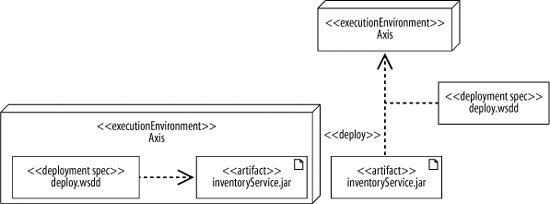Section 15.6. Deployment Specifications
15.6. Deployment SpecificationsInstalling software is rarely as easy as dropping a file on a machine; often you have to specify configuration parameters before your software can execute. A deployment specification is a special artifact specifying how another artifact is deployed to a node. It provides information that allows another artifact to run successfully in its environment. Deployment specifications are drawn as a rectangle with the stereotype <<deployment spec>>. There are two ways to tie a deployment specification to the deployment it describes:
The deploy.wsdd file, shown in Figure 15-19, is the standard deployment descriptor file that specifies how a web service is deployed to the Axis web service engine. This file states which class executes the web service and which methods on the class can be called. You can list these properties in the deployment specification using the name : type notation. Figure 15-20 shows the deploy.wsdd deployment specification with the properties className and allowedMethods. Figure 15-19. Equivalent ways of tying a deployment specification to the deployment it describes Figure 15-20. Showing the properties of a deployment specification: the notation on the right shows an instance populated with values The symbol on the right shows an instance of a deployment specification populated with values. Use this notation if you want to show the actual property values instead of just the types.
You don't need to list every property in a deployment specificationonly properties you consider important to the deployment. For example, deploy.wsdd may contain other properties such as allowed roles, but if you're not using that property or it's insignificant (i.e., it's the same for all your web services), then leave it out. |
EAN: 2147483647
Pages: 175
